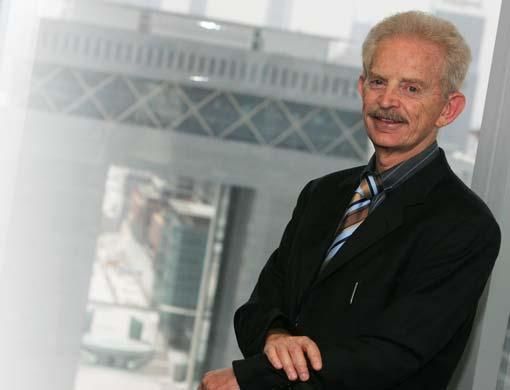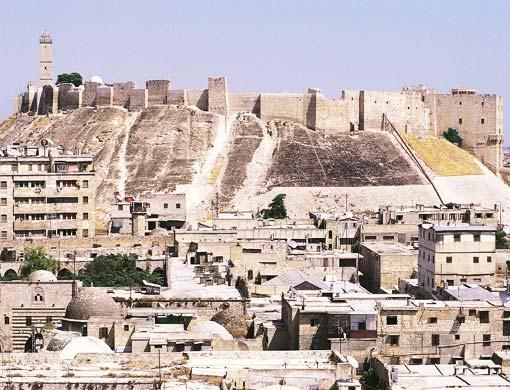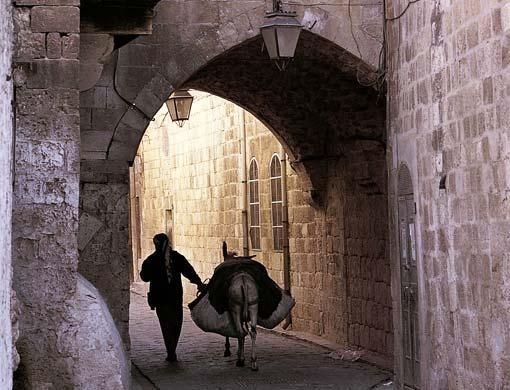Devastated to find that his birthplace Aleppo, in Syria, was going to be destroyed in the name of development, Adli Qudsi spent years campaigning for the conservation of the old city. The winner of the Rolex Award for Enterprise tells Suchitra Bajpai Chaudhary how he succeeded against many odds. Today, Aleppo is a Unesco World Heritage Site.
Think of, say, three truly happy moments of your life. Moments when everything seemed to be really perfect ... moments which still remain etched in your mind and of which you still think of fondly. Chances are nine out of ten, those special moments will be associated with a particular place and the person/s you were with.
Given a chance you would love to revisit those spots to relive those moments.
Now imagine if those places were to be destroyed in the name of development ... every little remnant of the area and its surroundings lost forever? Most of us would surely get depressed ... but after a few weeks or months would learn to put it all behind us and accept that it is all part of change and live with it.
But not Adli Qudsi.
Born in Aleppo in Syria, Qudsi spent the first 13 years of his life in the second largest city of Syria and one of the oldest inhabited cities of the world. After completing his education he moved to the US where he qualified to become an architect.
Spread over 355 hectares, the old city had 300 kms of narrow paved streets. Few homes in this city were taller than two storeys and the architecture of almost all houses was typical - rooms that opened to an expansive courtyard.
At its peak there were about 170,000 people living in the city. However as time went by and modern structures began to take shape in the newer areas of the city, the old city began to crumble with neglect and town planners begun ruthlessly razing old, historical structures in the name of development.
It was during this phase of change, sometime in the mid-1970s, that Qudsi returned to Aleppo from the US. What he witnessed shocked him. His cherished city was on the brink of being destroyed.
Any other person in his shoes would have complained, grumbled, criticised the government and then accepted the ruin of his home town. But Qudsi decided to pick up the cudgels against the ill-conceived move, change stubborn mindsets and cut through bureaucracy to resurrect his beloved city.
An architect known widely for his conservation and restoration practices, he took it upon himself to crusade for his home town Aleppo and ensure that posterity would be able to "touch and feel a piece of history''. To this end, he led a successful campaign to stop the destruction of the historical part of the city of Aleppo and convinced local authorities to adopt a full conservation policy and plan for the Old City.
No wonder this man was awarded the distinguished Rolex Award (see box) in 1998 in recognition of the grassroots work he did in Syria.
Qudsi was in Dubai recently as part of the Rolex team which announced
that next year's award ceremony will be held here.
He took some time off from his busy schedule to speak with Friday on his all-consuming passion for Aleppo, how he drew the mental strength to pursue with his mission - the restoration of his town - a stand that has been vindicated by the fact that in 1982, Unesco declared Aleppo a World Heritage Site!
As he talks of his happy days of childhood, the strongest memory that overwhelms him is that of a home where the soft fragrance of fresh jasmine flowers that his grandmother placed in every room used to linger for hours.
"I was born in 1947 in a courtyard house in the middle of the city of Aleppo. But the ethos of the quaint town was such that the year could have been a century or two earlier,'' he recalls.
The house was large with many rooms and a large courtyard in the centre that was fringed by numerous rose bushes and jasmine vines.
"It was a huge home with many rooms,'' he recalls.
"Even today, when I close my eyes, I can see my grandmother flitting from one jasmine plant to another, collecting basketfuls of flowers and hurrying to place them in each room of the house.
"I love the scent of jasmine. There also used to be many citrus trees and in the late spring, the air would be heavy with the fragrance of citrus flowers.
"The architecture of the house was such that it allowed little room for privacy. Every room opened into the courtyard and if you had to go from one room to another, there simply was no alternative but to pass through the courtyard. We had no interest in privacy, we loved the way the house was,'' he says. Qudsi was the only child of his parents, "but there were plenty of cousins in the house and we all grew up together''.
During summers, when the air in the courtyard was stifling the kids would scamper up to the terrace to sleep there. With a mosquito net hanging over them, Qudsi and his cousins would play games counting the stars and watching the moon play hide and seek with the clouds.
"It was fun growing up in a house like this,'' he says. "Usually within a compound there were several courtyard houses that were interconnected. There would be a collective open area outside the homes (the kunak) where men would sit together and receive visitors.''
Thanks to this architectural speciality, the children of the various houses could mingle freely and in safety.
"The city's streets were narrow and cobbled. In some areas, the streets were so narrow that it was quite impossible for vehicles to pass through,'' he says.
On the roads outside there were small shops and hammams "but certainly no modern boulevard. It was a people-friendly place and any child could play in anyone's house. If you got lost, people would recognise you and drop you home. I recall that until grade 2, an elder accompanied me to school. But from the third year, I was walking to school on my own or with friends.''
Qudsi lived in Aleppo until the age of 13. "Soon, we left the old city and eventually moved to the US where I did (a course in) architecture.''
It was sometime in the early '50s that the city began to deteriorate. The administration began to initiate plans to modernise the city and moves were on to expand old streets to accommodate larger roads. "There was (large-scale) destruction, houses were being brought down to accommodate broader streets and memories were being wiped out forever,'' recalls Qudsi.
"When I revisited Aleppo in 1975 for the first time after 17 years, I was stung by the scale of devastation.
"First I saw it as a tourist. Then I started getting drawn into it as I (realised) what was happening.''
It took some time for Qudsi to grasp the scale of the change. He realised that something had to be done or a slice of history would disappear for ever.
"I had worked in many organisations in the US that dealt with conservation of architectural heritage. I thought to myself, 'the house I was born in was probably 400 years old. It might have been built on an ancestral house which dated back a long, long time. Even the cobbled streets harked back to thousands of years'.
"At the very height of its glory, about 175,000 people lived in (Aleppo). I was very excited. I had to save it not just for historical reasons but (because) it was a piece of living history.''
The task was, of course, an uphill one. The city administration had a masterplan in place and it had a budget allocation for the new and modern city but nothing for the old one.
All attention was being showered on the new city. "The old houses in Aleppo were crumbling due to neglect. It had become a place for the poor. Those living there weren't interested in renovations. The Ottomans and the French had laid the water and sewerage systems, which were so old that water was seeping through the walls and ruining the buildings. The social fabric had broken up. No one seemed to be equipped to take on such a mammoth responsibility (of protecting and conserving the place).
"I felt having spent the happiest first 13 years of my life, I had to do something to revive it,'' says Qudsi.
"I feel people have a right to be in touch with history. And I feel it would be exciting if that history is physical where you can actually touch and relive it. Aleppo to me presented this exciting opportunity to reclaim this "physical evidence'' of what life was like years ago.
"As an architect I felt we had nothing to lose economically if we could revive a town that earlier had 130,000 people living in it. There were 300 monuments that included hammams, courtyard houses, caravanserai ... It would be much cheaper to revive that than build a new town.''
It may have been cheaper but it was a lot more tedious as Qudsi realised when he started meeting with the local people and officials at Aleppo. Arguing in favour of an old town with ancient roads and homes and an even more ancient drainage and sewerage system was not easy, particularly when a masterplan was almost in place that dictated the construction of large five-storey buildings and huge roads which would cut through the old town.
But what was in Qudsi's favour was his conviction. He was determined not to allow a slice of history to be destroyed. Finally after much arguing with the powers that be and after meeting with various authorities, he managed to move the minister of culture to register the place with the antiquities department.
"The next step was conservation,'' he says. "The people in the old city had no idea how to conserve it.''
Meanwhile the town authorities were keen to go ahead with the modernisation plans. The budgets had been okayed and the initial work had begun in earnest. Qudsi knew that he had to move fast if he had to stop it.
He dashed off letters to whoever he felt would help him in his endeavour. Help did come to him from various quarters. A few officials in the ministry of antiquities sympathised with Qudsi and threw their weight behind him. They helped him get in touch with several important people, ministers and dignitaries.
The letters paid off and finally the Cultural Minister passed a decree to register Aleppo and stop all renovations and demolitions until further notice.
It was a small victory for Qudsi but he knew it was not all over. He wanted Aleppo to be firmly on the map of conservation. And to this end he began corresponding with Unesco.
After a lengthy exchange of letters, the Unesco officials agreed to visit Aleppo in 1978.
They must have been overwhelmed by the city and its history because it did not take them long to declare it a World Heritage Site.
The Ministry of Culture now began to take a serious interest in the place. It set up an Old City committee to ensure that nobody destroyed any part of the city.
By 1990, all work on demolishing the city was shelved.
For Qudsi, it was still not over. Only the first leg of the struggle was ... the old city was still falling apart and it required funds. And fast.
Qudsi prepared a project report suggesting plans on how to go about renovating the city which was first discussed with the City Administration, and then with residents whose support was crucial in conserving the structures.
Qudsi wrote a report for a pilot project in one area of the city. His German friends helped him a great deal in this. They were so convinced about the importance of protecting this piece of history that was being threatened that they urged the German government to offer funds for the renovation.
Qudsi's wife, Arij Shalab Al Sham, actively campaigned for this and helped the Syrian side to work in collaboration with the German government.
The first job after the funds were in place was to save the crumbling infrastructure - the 300-km-long old streets had to be excavated and sewage pipes installed by the Ottomans and the water system put in place by the French, had to be replaced. The telephone lines that had been laid in the recent past had to be replaced.
The task was not an easy one. Streets had to be dug up in such a way that no house was blocked or cut off. Also, not all inhabitants of Aleppo were keen about the preservation drive. Some of them were struggling to live in their crumbling homes and had to deal with decrees that did not allow them to renovate or repair their homes. Qudsi realised that apart from garnering support from government officials, he would have to win the people over.
"The people of Aleppo were part of this and it was imperative to have them on our side. They had to be convinced that this exercise would help them physically, socially and economically. The Germans had conducted several social impact studies of such renovation projects and those studies gave us guidelines on how to involve the residents.'' So they began inviting people to brainstorming sessions hoping for some ideas to emerge.
But Qudsi realised that the process was not only laborious but also time-consuming and that they had very little time. "First surveys had to be carried out. We had to study people's lifestyle, the physical structures of individual houses, the needs of each house, incomes, and their desires. At one such meeting, a woman came up with a novel suggestion. She was exasperated with all talk and no action and suggested that while we were discussing, couldn't the residents get loans to renovate their homes?"
The suggestion sparked off a discussion and it was finally agreed that most people who lived there were poor, so interest-free loans would be provided to them, to be repaid in about four years.
Often when loans for such projects are involved they end up being written off as bad debt with only 20-30 per cent of the loans being repaid. But Qudsi was pleasantly surprised with the honesty of the people most of whom paid back the entire loan sum. "This idea from a housewife of Aleppo ultimately worked fine and also made for very active participation from the residents.''
In 1980 and 1983, he participated in the preparation of two Unesco reports on the conservation of Old Aleppo. His efforts led to the inclusion of Old Aleppo in Unesco's list of World Heritage Sites in 1986. In 1990, he authored and launched the "Project for the Rehabilitation of the Old City of Aleppo" and enlisted the support of the German government and the Arab Fund for Economic and Social Development in Kuwait.
It took him more than a decade of sheer hard work but the vision that he had for his town provided a glowing illustration of how the power of one man's conviction and determination can actually fire the imagination of a community and trigger an ecological revolution.
Aleppo continues to be conserved as Qudsi sees it as an ongoing project. More than the project what he did was to sow an idea in the minds of the people, an idea that has taken root, branched out and is still growing.
"We need at least 25 years to catch up on pending work.
"But the turnaround in attitudes is phenomenal. Now it is the city administration that is protecting the old town and restoring it.
A major fund has been created for its renovation. At a very modest investment of about $40 million we have managed to put the city on the right track. Of course more funds are required and more work has to be done.
"To me this project bought happiness beyond my wildest imagination," says Qudsi, childlike enthusiasm writ large on his face.
He feels recognition through Rolex legitimised his struggle and gave it the recognition on the world stage that he was looking for. "The Rolex Award was the best thing that happened to me. It not only brought me recognition from the old and the young, it also gave my project the much-needed exposure. In fact, I was touched because they organised an award ceremony especially for me as
I was the only person from this region. Now my project is internationally known.''
Since the recognition, two other awards - the Harvard and the Arab Cities awards - were also conferred on Qudsi for his work on Aleppo.
***
Now that Aleppo has been declared a Unesco World Heritage Site, is it in danger of being trampled over by overenthusiastic tourists?
Qudsi doesn't think so. "We considered that deeply. There were sections in Aleppo where there were lots of hotels, restaurants and other tourist attractions. Could this be harmful?'' When the commercial activities are good the residents are happy. "In the end it is all a matter of balance," he says.
Most of the cities in the Middle East are enjoying a period of rapid progress and modernisation and while it is essential to embrace the new lifestyle, Qudsi thinks it is not impossible to co-exist with the old and the traditional. He thinks the issue of conservation of heritage is very pertinent in the Middle East and there is a lot to be done in this area.
Restoration and conservation are two aspects that are pivotal to balancing the present with the past and Qudsi thinks much can be recovered in most Arab cities that is being rapidly lost "The next logical step is to restore and conserve many places that are in danger of being lost."
Qudsi is not a one-mission man and doesn't believe in resting on his laurels. Since Aleppo, he has got involved in many more projects.
He was appointed representative in Syria of the Aga Khan Trust for Culture in 1999. His firm's (Conception and Construction Consultants) work with the Aga Khan Trust involves the restoration and revitalisation of three castles in Syria and the rehabilitation of sections of Old Aleppo.
In 1995, he prepared a project paper entitled "Modernization of City Administration: Management, Urban and Environmental Planning" which is now the basis of an active EU project to upgrade six major municipalities in Syria.
In 2007, he initiated the "Aleppo Citadel Friends", a domestic civil society with the aim of supporting the administration, rehabilitation and maintenance of the Aleppo Citadel and its surroundings.
Qudsi today seems to be a happy and contented man. Maybe, one day he will be able to walk through the courtyards of an old house in Aleppo and smell the fragrance of jasmine that has just blossomed ... just like those old days.














